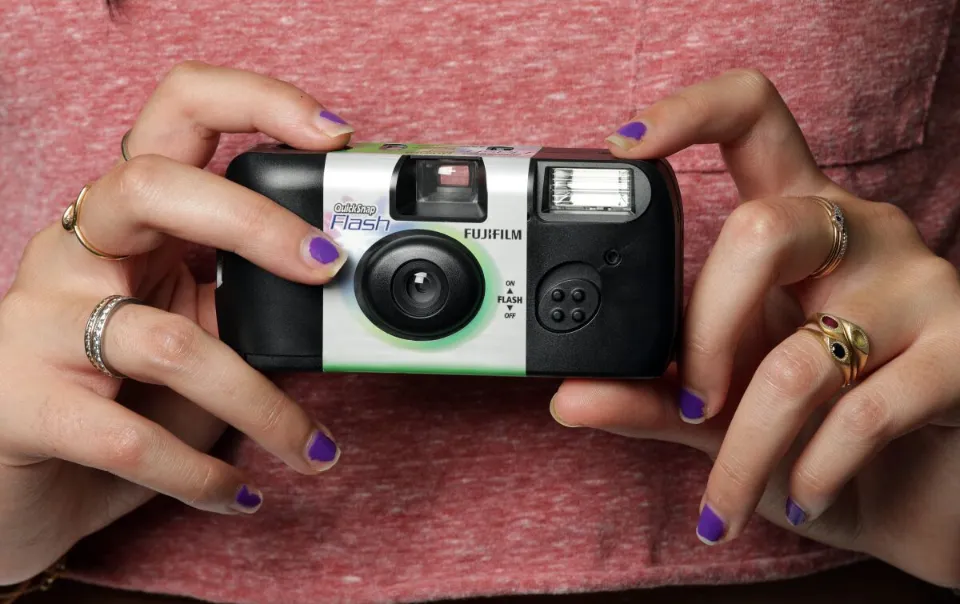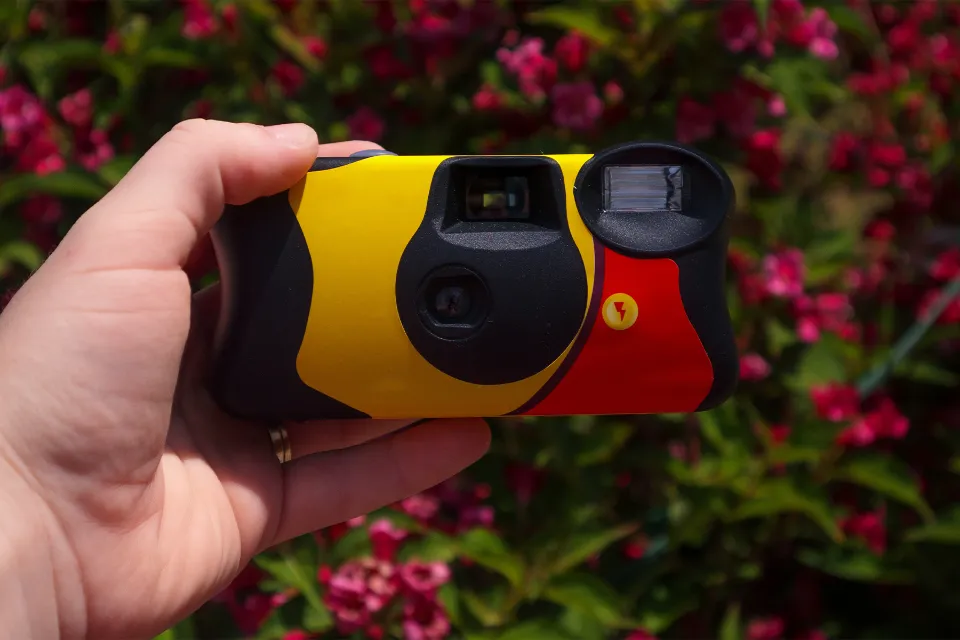Disposable cameras are dexterous tools for capturing images, and they have unique textures and qualities that digital cameras cannot replicate.
Wondering how do disposable cameras work? It adds a layer of suspense and excitement because you have to wait for the photo to be printed and you can’t view the image immediately after it is taken.

Fujifilm produces a wide range of easy-to-use and fun disposable cameras. To take a picture, turn the scroll wheel until it is no longer turning. Then, if you need extra light, slide the button on the front of the camera up to turn on the flash. Point the camera at your eyes and click the button on the top of the camera to take your photo.
How to Take Photos with Disposable Camera?

1. Turn the scroll wheel to the right to advance the film in the camera. before taking a picture, you need to advance the film inside the camera into an empty frame. To do this, place your thumb on the horizontal scroll wheel embedded next to the camera’s viewfinder. Turn the steering wheel to the right with your thumb. Keep rolling the scroll wheel until it no longer turns.
The scroll wheel on Fujifilm’s waterproof disposable camera is bright green and is located on top of the camera.
If you do not turn the scroll wheel completely before taking the photo, your camera will not take the picture.
Rollers are often referred to as thumb wheels.
2. Slide the button on the front of the camera up to turn on the flash. If it’s dark outside and you think you need an extra light source, turn on the flash. To do this, look at the front of the camera and find the large button with 4 grooves next to the lens. Swipe up to charge the flash. When the flash charges, you will hear a sharp sound. Wait 2-5 seconds for this sound to end. After the sound wears off, the flash is ready.
You can do this before or after turning the wheel – it doesn’t really matter.
Turn on the flash only when you’re shooting in low-light conditions and trying to photograph an object 8–36 feet (2.4–11.0 m) ahead.
If you don’t want to use the flash, just ignore this button and keep it in the off position. Some Fujifilm disposable cameras do not have a built-in flash.
3. Raise the camera to your eyes and look through the viewfinder. Viewfinder is the transparent rectangle you see through the back of your camera. Point the viewfinder at your dominant eye and frame the picture with it. Adjust the camera to change the composition of the subject so that people, landscapes, or still lifes are composed in interesting ways.
Pay attention to the light source. In general, you want the light to hit your subject at an angle. Avoid shooting directly into or away from the light source.
In photography, the rule of thirds is a good general rule for composing a subject. Try using this rule by adjusting the position of the camera, placing your subject vertically or horizontally in a third of the composition.
4. Take a photo press the button on the top of the camera. Hold the camera as steadily as possible. To take a picture, press the button on the top of the camera all the way. When you hear the click, the shutter has finished opening and closing, and your photo has been taken. Release the button to finish taking the photo.
On the waterproof model, there is a lever on the front of the camera instead of a button on the top. To take a photo with a disposable waterproof camera, pull the lever all the way down until you hear a click, then release.
5. Continue using the camera until the film runs out. Each Fujifilm disposable camera has 27 exposures. To determine how many photos you have left, look next to the button on the top of the camera to take a photo. There is a piece of clear plastic with numbers printed underneath. This number indicates how many photos you have left.
Don’t forget to turn the scroll wheel before taking each photo.
Once you run out of camera roll, you can’t take any more photos.
Some Fujifilm cameras do not display an indicator of the number of photos remaining.
6. Develop your film in a photo studio or pharmacy. When you finish, take it to the photography lab to develop your disposable cameras. Alternatively, you can take the camera to your local pharmacy or pharmacy, as long as they have a photo printing department. If you don’t have a store near you that develops your photos, mail your camera to a company that will process your film remotely before sending it back to you.
Some photo studios may be able to process your film in as little as 1 hour, but if some stores are very busy, it can take days.
Pick up the photos after flushing them.
It usually costs $8.00-$20.00 to process the film inside a disposable camera.
With the right supplies, you can even develop film at home.
Read More about disposable camera developing:
How to Select Disposable Camera?

1. Get a QuickSnap 35mm camera with flash for general shooting. Fujifilm’s standard camera is the most common model on the market. Flash makes shooting at night or cloudy easier, but you can turn the flash on and off between shots if you want. The flash can be turned on before each shot by flipping the button next to the lens embedded in the front of the camera.
35mm refers to the focal length of the lens. Essentially, it is how wide the angle of the camera is. 35mm is the standard default setting for most disposable cameras.
Fujifilm once produced an outdoor model without a built-in flash. It was a camera that was very popular among creative photographers, but Fujifilm has been discontinued.
2. Buy a QuickSnap waterproof camera to shoot in wet conditions. Fujifilm’s second most popular camera is the waterproof camera. It can be completely submerged in water up to 17 feet (5.2 meters) deep, but still take high-quality photos. This is a great option if you’re traveling to a rainy destination or don’t want to worry about your camera being ruined on the beach.
The QuickSnap waterproof camera comes with a built-in strap that won’t be lost even in water.
QuickSnap is available in 400 or 800 ISO film versions. The higher the ISO, the coarser the image is usually located. However, images taken at lower ISOs are more likely to end up out of focus.
Fujifilm’s waterproof camera does not have a built-in flash.
3. Use Superia cameras to obtain the highest quality images. The Fujifilm Superia camera is often considered the best disposable camera in Fujifilm, but it is harder to find and usually more expensive because of the high quality of the film in the camera. It also comes with a built-in flash for shooting in low-light conditions.
Superia is also the name of one of the film manufacturer’s brands, so if you’re buying online, make sure you’re buying a disposable camera, not just film.
The QuickSnap camera uses 400 ISO film, while the Superia uses 800 ISO film. To compensate for higher ISO, Superia uses a higher shutter speed, so images are generally more accurate.